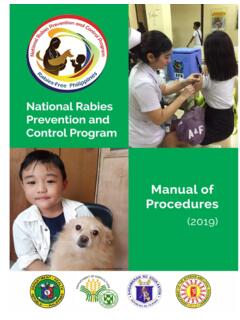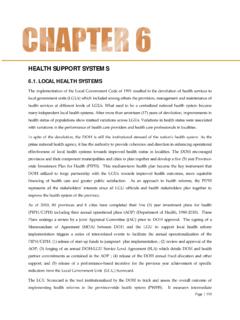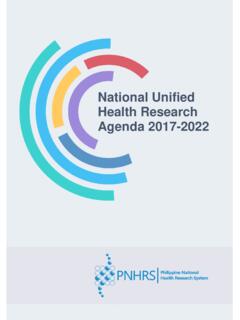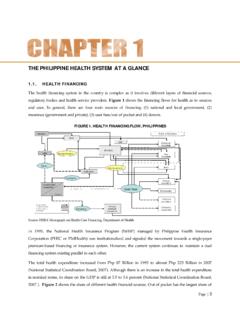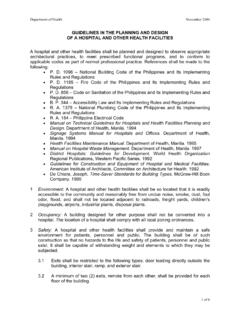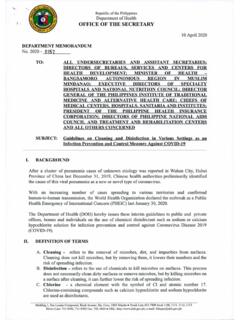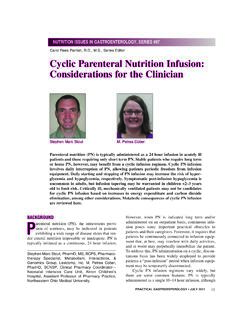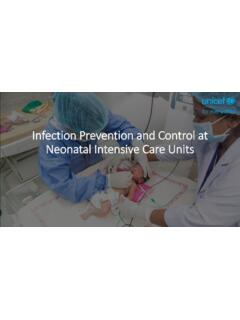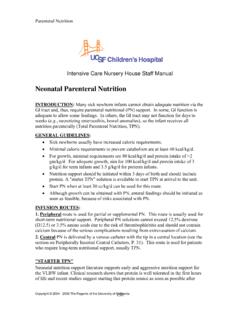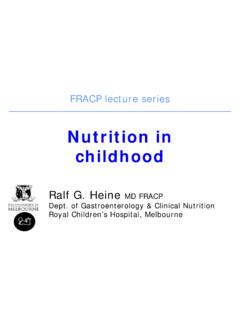Transcription of MNCHN MOP June 16 attachment - Secretary of Health
1 E 2 TABLE OF CONTENTS DEFINITION OF TERMS 3 FOREWORD 5 DEPARTMENT MEMORANDUM 6 SCOPE AND COVERAGE 7 CHAPTER 1: INTRODUCTION 8 CHAPTER 2: MNCHN STRATEGY: OVERVIEW 13 CHAPTER 3: MNCHN SERVICE DELIVERY 16 CHAPTER 4: REGULATING MNCHN SERVICES 24 CHAPTER 5: FINANCING MNCHN SERVICES 32 CHAPTER 6: GOVERNANCE MECHANISM FOR MNCHN 43 REFERENCES 77 LIST OF ATTACHMENTS: 1.
2 PREGNANCY TRACKING FORM 2. WHT MATERNAL DEATH REPORTING FORM 3. FACILITY MATERNAL DEATH REPORTING FORM 4. MNCHN MONITORING FORM 5. AO 2008-0029 3 DEFINITION OF TERMS Antenatal Care Coverage is an indicator of access and use of Health care during pregnancy. It constitutes screening for Health and socioeconomic conditions likely to increase the possibility of specific adverse pregnancy outcomes, providing therapeutic interventions known to be effective; and educating pregnant women about planning for safe childbirth (facility-based deliveries), emergencies during pregnancy and how to deal with them.
3 (WHO; Indicator Definitions and Metadata 2008) Basic Emergency Obstetrics and Newborn Care (BEmONC) Provider is a capable private Health facility or an appropriately upgraded public Health facility that is either a Rural Health Unit (RHU) and/or its satellite Barangay Health Station (BHS) or Hospital capable of performing the following emergency obstetric functions: (1) parenteral administration of oxytocin in the third stage of labor; (2) parenteral administration of loading dose of anti-convulsants; (3) parenteral administration of initial dose of antibiotics; (4) performance of assisted deliveries in imminent breech; (5) removal of retained placental products ; and (6) manual removal of retained placenta.
4 It is also capable of providing neonatal emergency interventions, which include at the minimum, newborn resuscitation, provision of warmth, and referral. The hospital BEmONC shall also be capable of providing blood transfusion services. These facilities can likewise serve as high volume providers for IUD (intra-uterine device) and VSC (voluntary surgical contraception) services. It can also be a single or stand alone facility or part of a network of facilities in an inter-local Health zone.
5 Comprehensive Emergency Obstetrics and Newborn Care (CEmONC) Provider is a tertiary level regional hospital or medical center, provincial hospital or an appropriately upgraded district hospital. It can also be a capable privately operated medical center. It is capable of performing emergency obstetric functions as in BEmONC provider facilities, as well as provides surgical delivery (caesarean section) and blood bank transfusion services, and other highly specialized obstetric interventions.
6 It is also able to provide emergency neonatal care, which include the minimum: (1) newborn resuscitation; (2) treatment of neonatal sepsis/infection; (3) oxygen support; and, (4) antenatal administration of (maternal) steroids for threatened premature delivery. It can also serve as high volume providers for intra-uterine device (IUD) and voluntary surgical contraception (VSC) services. Contraceptive Prevalence Rate (CPR) is the proportion of women age 15-49 years reporting current use of a modern method of family planning, pill, IUD, injectables, condom, mucus method, basal body temperature method, standard days method (SDM), and lactational amenorhea method (LAM).
7 High volume providers for IUD and VSC are RHUs (for IUDs) and hospitals (for IUDs and VSCs) and accredited private clinics having sufficient case load to maintain a certain level of proficiency, about 1-2 per day or more so that the service is part of a sustainable practice and receive appropriate support from the LGUs. 4 Infant Mortality Rate refers to the number of infants dying before reaching the age of one year per 1,000 live births in a given year.
8 It represents an important component of under-five mortality rate. Integrated MNCHN Service is a package of services for women and children covering a spectrum of known cost-effective public Health and clinical management measures capable of reducing exposure to and the severity of risks for maternal and neonatal deaths, as well as preventing their direct causes, that are within the capacity of the Health system to routinely provide. Maternal Mortality Ratio (MMR) refers to the number of women who die from any cause related to or aggravated by pregnancy or its management (excluding accidental or incidental causes) during pregnancy and childbirth or within 42 days of termination of pregnancy, irrespective of the duration and site of the pregnancy, per 100,000 live births.
9 Maternal, neonatal and Child Health and nutrition ( MNCHN ) Service Delivery Network refers to the network of facilities and providers within a province and (chartered) city Health system offering integrated MNCHN services in a coordinated manner, including the supporting financing, communication and transportation systems. Such network includes the BEmONC-CEmONC network (a network of facilities providing emergency obstetric and newborn care) and matches the Inter-Local Health Zone (ILHZ) arrangement.
10 neonatal Mortality Rate refers to the number of deaths within the first 28 days of life per 1000 live births in a given period. It serves as an indicator of maternal and neonatal Health care. Province and City Health Systems refer to an organized scheme for delivering Health services including the integrated MNCHN service package in a contained geographic area covering an entire province and city. It is divided into small sub-systems consisting of public and private providers organized into Inter-Local Health Zones (ILHZ).

